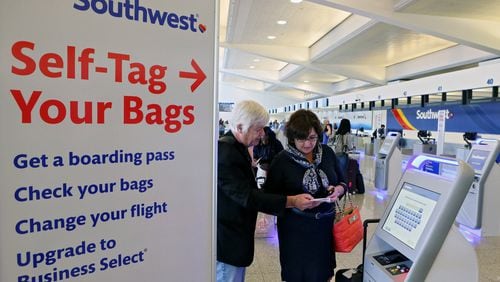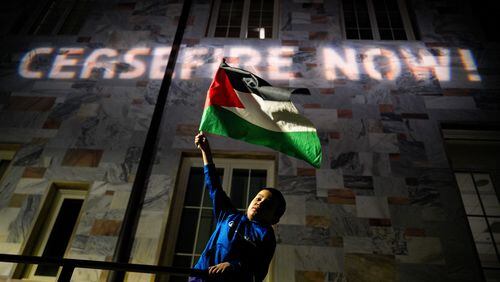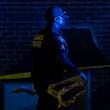Airlines are finding more ways to have their customers process themselves at the airport.
Carriers are getting closer to the day when you might make it all the way from curb to cabin while barely speaking to a single person.
One of the latest examples of the trend: Self bag-tagging kiosks.
Southwest Airlines, the second-largest carrier at Hartsfield-Jackson International Airport, in July installed kiosks at the Atlanta airport that allow passengers to check in, print their own bag tags and slap the adhesive tags onto their luggage. The Dallas-based airline is rolling out the new kiosks around the country.
Having passengers tag their own bags means fewer tasks for Southwest employees to handle, and ideally, less time that passengers have to wait in line.
It also “frees up agents to do more of the customer value work, instead of the repetitive tagging of bags,” said Joe Licitra, vice president of airline sales in North America for SITA, an air transport technology firm with regional headquarters in Cobb County that makes the Southwest kiosks.
Passengers still walk up to the counter to hand their luggage to an employee to be weighed and checked, and the airline has agents in the kiosk area who can help customers with the devices. In fact, Southwest said it hasn’t reduced its number of customer service agents.
The airline started testing self-tagging kiosks at Dallas Love Field in 2014, before this year rolling out new kiosks made by SITA.
Grocery store self-check led the trend that has customers “wanting to self-serve” in many situations, said Southwest innovation team consultant Cindy Ritner.
“It’s an opportunity for them to be in a little more control of how they get through the airport,” Ritner said.
Regular kiosks are still available, as well as full-service counters for those who “really need end-to-end service,” Ritner said.
And what about the inevitable cases where a self-tagger gets the tag twisted or snarled or otherwise fumbles the attempt? They can go to a help desk to have a tag reprinted.
Other airlines have also launched self bag-tagging in some airports, including United, American, Alaska and JetBlue. So far, Atlanta giant Delta Air Lines is not among them.
Southwest, which allows passengers to check two bags for free, has kiosks equipped with a double roll of bag tags, according to Licitra.
Another option for passengers flying on Alaska Airlines out of Atlanta and a number of other airports is printing bag tags at home on regular paper, which can be inserted into a tag holder mailed to the passenger or picked up at the airport.
“The idea is that airlines are trying to find way to make the entire passenger experience quicker and easier,” said Rob Borucki, director of product management for the travel and entertainment group at Duluth-based NCR, which provides the self-tagging technology to Alaska Airlines.
More customers, same space
The move toward more self-service options comes as airlines look for ways to move people through the airport lobby quickly, to be “able to take on more customers in the same limited space… and really the same number of agents,” Licitra said.
Some airlines including Delta have tested self-boarding gates, using a boarding pass scanner and turnstile-type gate. Delta spokeswoman Ashton Morrow said the test several years ago “didn’t move the needle the way we hoped for our customers.” But Delta and other airlines continue to experiment with different boarding procedures.
Security processes in the airport are becoming more automated as well:
— With new “smart lanes,” the Transportation Security Administration is automating some of the work its screeners do, such as returning bins to the front of security lanes.
— Biometric identification technology firm Clear operates at some airport security checkpoints by allowing passengers to scan their boarding pass and fingerprints for entry into certain security lanes. The membership fee-based service is set to come to Atlanta in coming months.
— U.S. Customs and Border Protection now uses kiosks to expedite the process for travelers re-entering the country before they are cleared by a Customs agent, and allows passengers to enter information into a mobile passport app.
As technology progresses, just how much of the travel experience can be done with self-service?
Self-service important
According to Delta, customers say in surveys that “self-service options are important to them.”
Delta is “exploring how we can use technology to improve the airport experience at all stages,” including check-in, boarding and baggage handling, Morrow said.
Companies that specialize in kiosks and passenger processing technology, including NCR and SITA, envision a much more streamlined path through the airport.
“One of the things we’re working on is automating the whole airport security process… where customers will only have to check-in basically on time,” with a scan of the passenger’s face and device at a kiosk in the lobby, for example, Licitra said. “Then you’d be in the system” on a “smart pass.”
Borucki said the “whole industry is interested in and exploring” the concept.
“It could be using your face as a boarding pass or using your fingerprint as a boarding pass, and with that you’ll go through security, you’ll open self-boarding gates,” Borucki said.
The concept will require much more time, work and coordination with governments around the world, Licitra said. But in the long run, he said, “we’re trying to automate as much as we can [so] customers aren’t inconvenienced, but security is not questioned.”
About the Author







